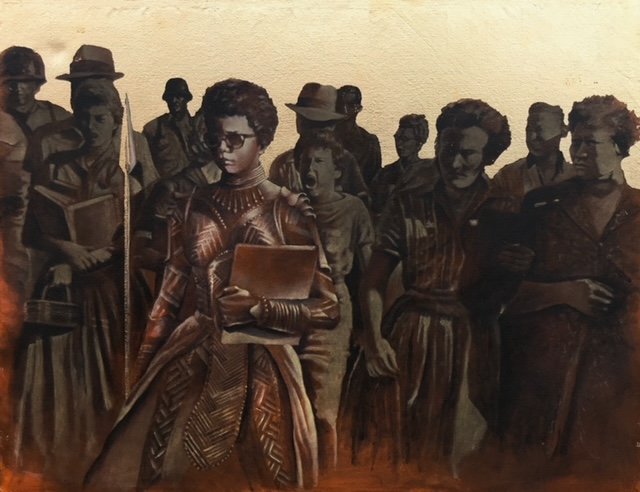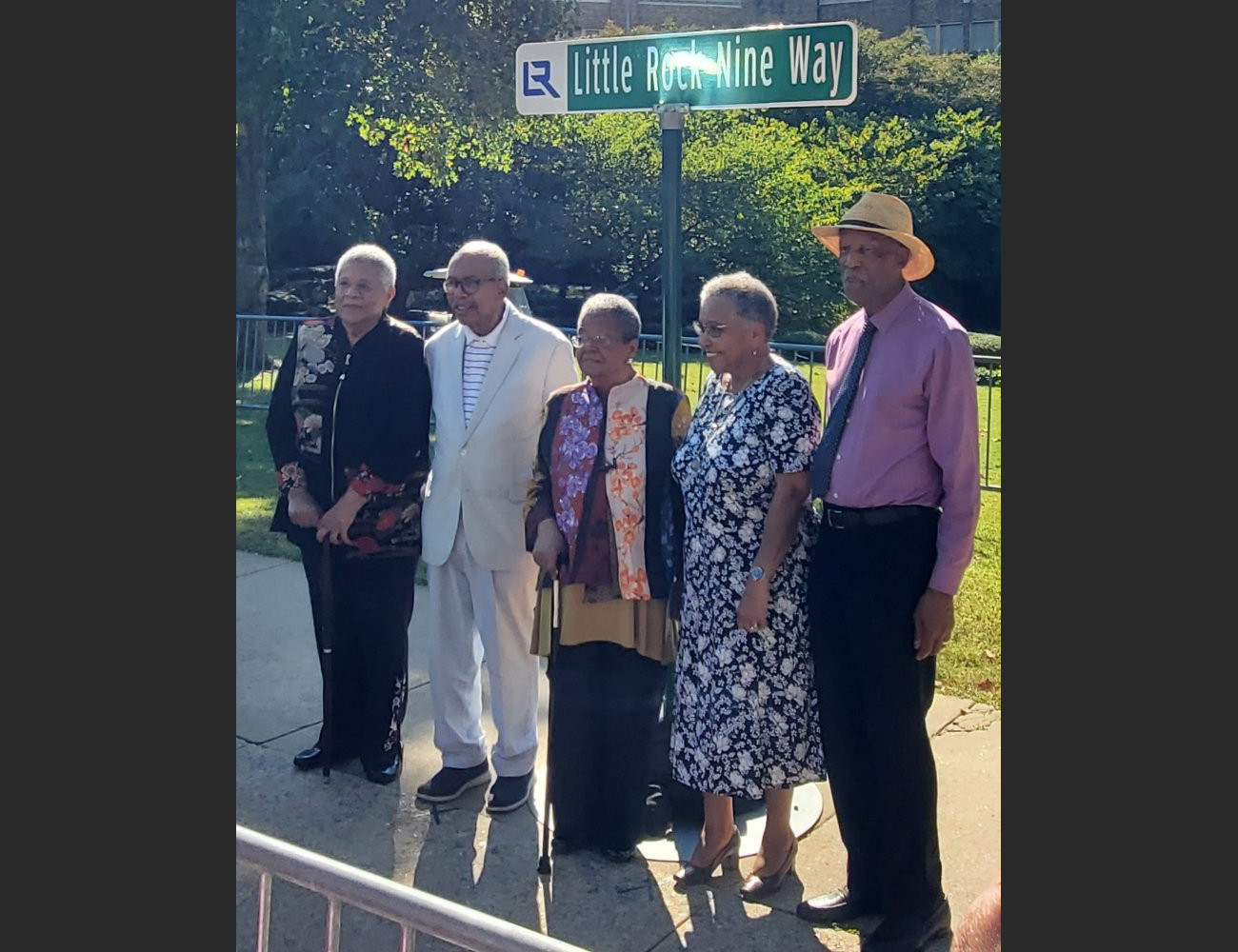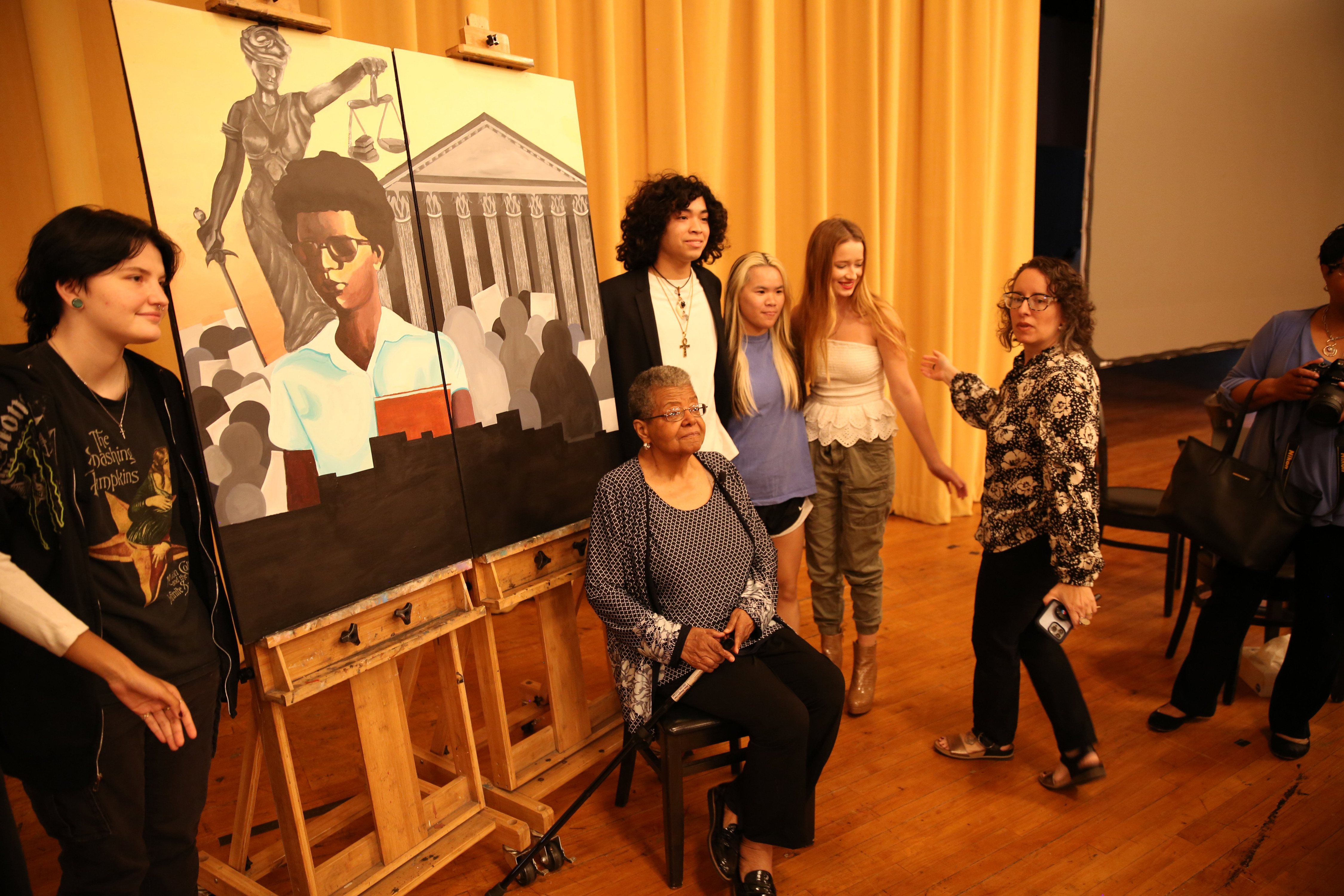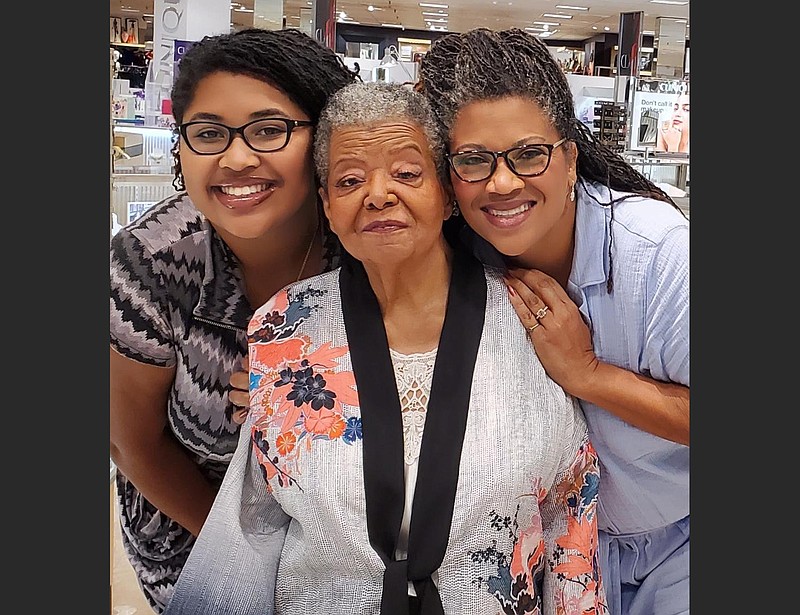True grace and beauty radiate from within. And, during the September events commemorating the 65th anniversary of the desegregation of Little Rock Central High in 1957, civil-rights Icon Elizabeth Eckford of the Little Rock Nine absolutely glowed.
Since my daughter Grace and I helped Eckford share her story in her biography, "The Worst First Day: Bullied While Desegregating Central High" five years ago, close friends have noted how much Eckford has blossomed due to having the opportunity to share her truth.
No longer one to remain quietly in the background, Eckford has stepped into the spotlight. Her audiences marvel and are uplifted when they hear her speak. She is a storyteller at heart, one with the innate ability to interweave civil rights history with her memories growing up in the segregated south of Little Rock and as a member of the Little Rock Nine.
My children and I have watched Eckford's confidence and countenance develop exponentially with each presentation at schools, colleges and corporations. A humble person, she would never describe herself as beautiful, but that is because she doesn't see herself through the eyes of her audiences. It is not unusual to see tears fall as she speaks; people are moved by her perseverance and impressed by her strength. They thank her for the impact she has had on the world by being a part of this country's earliest desegregation struggle.
Several of the programs for the commemoration addressed the issue and effect of trauma and the importance of mental health. Eckford is an example of someone who has healed significantly from her trauma due to her own version of exposure therapy by talking through her experiences with audiences. Her experiences at Central will never leave her, but they no longer define her.
Little Rock Central High School National Historic Site Interpretive Park Ranger Randy Dotson, who often escorts Eckford to local events, noted her transformation.
"Seeing Elizabeth now compared to 2016 when I first became a park ranger has been amazing," Dotson said. "I have seen her personality come out. I've watched her take control. She has come into her own."
Two events taking place in November are close to Eckford's heart: Veterans Day and the premiere of "Black Panther: Wakanda Forever." Both are important for different reasons. Few realize that Eckford is a veteran. Inducted into the Women's Army Corps in 1967, she served as a pay clerk and an information specialist at Fort Benjamin Harrison, Ind., and Fort McClellan, Ala., until she separated from the Army in 1972.
Eckford and the late Jefferson Thomas were the only members of the Nine to serve in the military. In July, Eckford and I presented for the National Association of Black Military Women; our focus was the impact of long-term trauma. Afterward, many "women warriors" shared with us that they had been hesitant to seek help for issues such as post-traumatic stress disorder and military sexual trauma, but felt encouraged to seek treatment after hearing our presentation.
In October, Eckford's military service was recorded at the 25th anniversary celebration of the Military Women's Memorial in Washington. The memorial honors the often-overlooked sacrifices of female service members. Specialist Eckford's Army photo and a synopsis of her military experiences were recorded in its national registry. Eckford's military mindset explains why she remains "on a mission" to combat racism and discrimination as she shares her truth.
The premiere of "Wakanda Forever" on Veterans Day, which was Friday, reminds Eckford of a special image created by Little Rock Central High graduate Ajamu Kojo: "Wakanda Don't Cry." Kojo created the artwork in 2018 in tribute to the first "Black Panther" movie, fashioning Eckford as a member of the Dora Milaje, King T'Challa's elite group of warriors and personal royal guard.
"I thought of the strength it took for an adolescent to face a venomous and racist crowd during the civil rights movement in Little Rock, Arkansas," Kojo said. "To me, she personifies fearlessness, strength, honor and dedication. And so, she became a member of the Dora Milaje. Nothing could penetrate her adornment. She would be forever protected by a much higher power."
Eckford loves the image and has it hanging in her home. "It is the only rendering of the mob scene that makes me feel empowered," she said.
 Elizabeth Eckford, a member of the Little Rock Nine, is depicted as a member of the Dora Milaje — the all-female army in the “Black Panther” Marvel comic and movies — in Central High graduate Ajamu Kojo’s work “Wakanda Don’t Cry” (Mischtechnik and gilding on linen canvas, 34-by-44 inches) (Special to the Democrat-Gazette)
Elizabeth Eckford, a member of the Little Rock Nine, is depicted as a member of the Dora Milaje — the all-female army in the “Black Panther” Marvel comic and movies — in Central High graduate Ajamu Kojo’s work “Wakanda Don’t Cry” (Mischtechnik and gilding on linen canvas, 34-by-44 inches) (Special to the Democrat-Gazette)
THAT WORST FIRST DAY
On Sept. 4, 1957, Eckford arrived at Central High with a mixture of emotions. She was excited and apprehensive about her first day of school and hoped to meet new friends ... only to face an enraged segregationist mob alone. At the time, she was a 15-year-old 11th-grader and was very scared of by the people who surrounded her and threatened to hang her. Grace was the same age — 15 — when she helped write Eckford's biography, which provided an intergenerational approach to "The Worst First Day."
Eckford rebuffs descriptions of her as "courageous" that day, descriptions stemming from the image of her stoic countenance in the famous photo captured by photographer Will Counts. Eckford tells audiences she hid behind the glasses she wore due to photosensitivity, terrified of potential violence from the crowd. For help, she approached one elderly white lady who seemed to have a kind face, but the woman spat on her. Eckford remembered the photo of Emmett Till's disfigured body that had been published in Jet magazine a few years prior and knew the crowd's threats were not idle. She raced to the bus bench, which somehow represented safety in her mind. (Eckford was thrilled when the Central High Memory Project re-created that bench in 2018 in her honor, primarily due to community involvement from numerous volunteers across the community.)
Due to the significant trauma Eckford experienced at Central, she remained silent for years. However, she became irritated by the repeated efforts of many to revise the narrative regarding what happened to the Nine — and why changes from a segregated to an inclusive society have occurred, primarily due to the impact of civil rights court cases. Deniers refuted the physical, verbal, emotional and mental attacks the Nine endured and diminished the significance of the Nine's contributions to society. Additionally, she was distressed by the number of students who were committing suicide due to bullying. She knew it was time to speak out, so she finally allowed my daughter and me to help her share her narrative. "Anyone who says that we were not harmed is lying and they know it," Eckford said.
Forty years after leaving Central, Eckford began to tell her story to students. Her early efforts to present were extremely difficult, causing her to become overwhelmed. Invariably, she would end up in tears and be emotionally drained after presentations. "I will always appreciate their kindness and patience with me," Eckford said of her young audiences. Their attentiveness and concern made it easier for her to navigate through the painful memories of her past in the hope of providing mentorship and guidance that would influence students' futures in a positive way.
 Members of the Little Rock Nine — Minnijean Brown Trickey, Ernest Green, Elizabeth Eckford, Gloria Ray Karlmark and Terence Roberts were present at the renaming of the street in front of Central High to “Little Rock Nine Way” as part of the 65th commemoration on Sept. 25. (Special to the Democrat-Gazette/Grace A. Stanley)
Members of the Little Rock Nine — Minnijean Brown Trickey, Ernest Green, Elizabeth Eckford, Gloria Ray Karlmark and Terence Roberts were present at the renaming of the street in front of Central High to “Little Rock Nine Way” as part of the 65th commemoration on Sept. 25. (Special to the Democrat-Gazette/Grace A. Stanley)
WOMAN OF STYLE
A woman of style with an eye for fashion since her youth, Eckford, along with her sister Anna, made the famous dress she wore on her first day of school. Eckford has always been an enthusiastic shopper who enjoys buying the latest styles, but due to the ordeal experienced at Central, she eschews crowds at all costs, preferring to shop from catalogs. Additionally, she avoids loud noises and often jumps when she hears them, because based on her experience, sharp sounds usually preceded attacks. Prior to our presentations over the past five years, audiences were asked to wave their hands in silent praise after presentations instead of applause. This request was made to protect Eckford's countenance, a courtesy they gladly extended. Since then, she is not as affected by noise and has become receptive to audiences clapping. It has been a remarkable progression, one that most wouldn't even notice or would take for granted.
From Sept. 22-26, Eckford participated in activities to commemorate the 65th anniversary of the desegregation of Central High with four other members of the Nine who were present: Ernest Green, Gloria Ray Karlmark, Minnijean Brown Trickey and Dr. Terrence Roberts. Two others, Dr. Melba Pattillo-Beals and Carlotta Walls Lanier, participated via Zoom. Prior to the event, we went shopping at Dillard's to buy some clothing articles I had forgotten, but as soon as we entered the door Eckford saw a lovely kimono and a gorgeous fall-colored jacket that were both striking on her. She said she was going to "strut her stuff" during the 65th commemoration events, which she did. She navigated the events with confidence, style and grace. Her comments were so eloquent at the official ceremony that even former President Bill Clinton took note. During her observations, Eckford announced that she would be speaking to Central High students for the first time in 65 years and said how much she was looking forward to her presentation. "I talk to a lot of students over the phone and in person, and one of the things that I always have to correct them about is they think that I was brave, but that stoicism that was shown in that famous photograph is what you see when you're trying not to cry," she said. "I want young people to understand that they need to know themselves so other people can't tell them who they think they are." She further encouraged students to invest in themselves, believe in themselves and be empowered.
Clinton, who has known the Little Rock Nine for many years from hosting numerous commemorations of the desegregation of Central High, commented on Eckford's countenance during his keynote address, stating that the purpose of education was to prepare students for the rest of their lives and asking, "Who were we to deny that?" He praised the Nine. "Think of the way they came up here and talked. Elizabeth didn't talk for a long time, and she came up here and made more sense than most of the people I've heard giving speeches for 50 years." Clinton awarded the Nine the Medal of Honor in 1999, the nation's highest civilian award.
A CENTRAL FIGURE
On Sept. 26 — 65 years after the 101st Airborne escorted Eckford and the Little Rock Nine into Central High — Eckford returned to her alma mater to share her powerful story with more than 2,500 intrigued students. It was the first time she was invited to speak to the student body since leaving in 1958 after Gov. Orval Faubus shut down the entire school system in an attempt to prevent desegregation.
The second group of Black students to attend Central was smaller than the original Nine and included Dr. Sybil Jordan Hampton, a higher education administrator and former President of the Winthrop Rockefeller Foundation. Hampton wrote the preface to "The Worst First Day" and describes Eckford's story as "a compelling, modern-day Odyssey set during the civil rights era." Hampton was in the audience during our presentation and raved about Eckford's performance afterward. "The change is remarkable," she said. "I am so happy for Elizabeth. She has come into her own."
The audience appreciated our inter-generational approach to presenting Eckford's story. Grace, currently a sophomore at Florida A&M University, read passages from "The Worst First Day," which I followed with questions for Eckford. With each answer, Eckford shared key civil rights facts while emphasizing that what she did was not unique — any student could do what she did.
"The students were awe-struck by Elizabeth's story and the messages that she shared," said Central High Principal Nancy Rousseau. "They were captivated and talked about what they heard all week long. Our teachers have previously shared the same information as school history, but coming from her, it meant so much more."
Prior to our presentation, a stunning mural created by several Central High art students in preparation for Central High's 100th anniversary was unveiled. Eckford was in the foreground with the Supreme Court and the scales of justice behind her. (Eckford's attempted entry into Central High has been replicated numerous times, but the artwork created by Central students over the years reflects their connection to what she endured and great admiration for Eckford. Many of their art pieces were incorporated into "The Worst First Day.")
After our presentation, students were eager to meet Eckford and obtain a signed copy of her book. The line extended outside the library and down the sidewalk.
 Elizabeth Eckford poses with the Little Rock Central High art students and teachers who created an interpretation of her first day of school for the school’s forthcoming 100th anniversary in 2027. (Special to the Democrat-Gazette/Kirk Jordan)
Elizabeth Eckford poses with the Little Rock Central High art students and teachers who created an interpretation of her first day of school for the school’s forthcoming 100th anniversary in 2027. (Special to the Democrat-Gazette/Kirk Jordan)
A LATE DIAGNOSIS
Incredibly, despite the attacks the Nine experienced every day at Central, Eckford wasn't diagnosed with PTSD until 1980. She suffered in silence for years. In 2014, Eckford's doctor prescribed exposure therapy to help heal the hurt, tasking her with walking back and forth in front of Central High while reciting what she saw, felt and experienced on her first day of school aloud until it no longer had an impact on her. I walked alongside her and videotaped her journey, just as I have been grateful to walk with her and be mentored by her since we became friends in 1999.
Sadly, it took 20 years to convince Eckford to tell her story, because she had internalized her experiences at Central and did not think anyone would be interested in what she had to say. But since "The Worst First Day" was published five years ago to commemorate the 60th anniversary of the Central High crisis, Eckford has discovered that her true healing took place from sharing her story, particularly with children.
The theme of the 65th commemoration was "Silence is not an Option." Eckford, who remained busy after the commemoration with several additional engagements, is no longer silent.
Dr. Eurydice Stanley is an international motivational speaker, author, and coauthor of "The Worst First Day: Bullied While Desegregating Central High," available on Amazon. See more about her at dreurydice.com.
